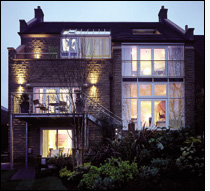Four members of the Parnell family—Nick and Sue and their daughters Lucy, 16, and Hazel, 13—have volunteered to live in a five-bedroom house in Sheffield, England, and have their movements tracked 24/7 by RFID. No, it’s not the BBC‘s latest TV reality show, but a research project to learn how family dynamics and lifestyle are influenced by house design.
It’s called Project: LIFE, and it’s being conducted by David Wilson Homes, which built the concept house, and the University of Nottingham’s School of the Built Environment. For three two-week stints during the six-month project that started in May, each family member, as well as any visitors, will wear an active RFID wristband from Wavetrend Technologies. The wristband’s tag emits a signal every four seconds, which is read by one of the 26 Wavetrend interrogators installed in the walls of the four-floor, 3,500-square-foot home. An RFID network collects the movements of each of the occupants.
RFID was chosen over sensors or camera monitoring because it provides the least obtrusive means of carrying out a 24-hour study of how the building is being used, says Mark Gillott, a lecturer at the university’s Institute of Sustainable Energy Technology.
Researchers from the university will analyze the data and conduct follow-up interviews with the family. They also want to see whether the way a home is actually used can influence design to reduce energy consumption. RFID technology could be integrated into building management systems, so that lighting, heating and ventilation systems could be adjusted automatically, depending on where people are in the house.
The findings will not be released until after the project ends in November. Some will see this as Big Brother technology. Others will relish the idea of a house that automatically adjusts the temperature and lighting to their preferences. Call it “big mother.”


